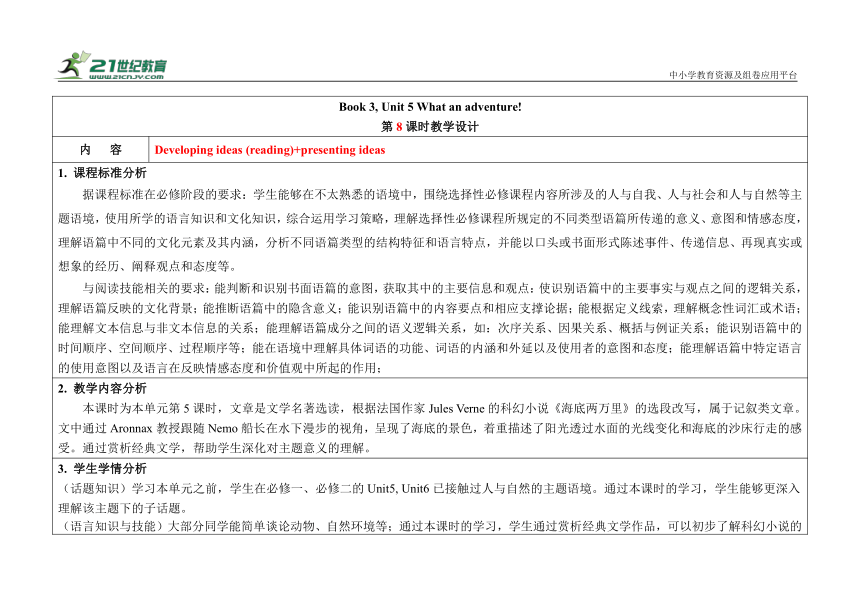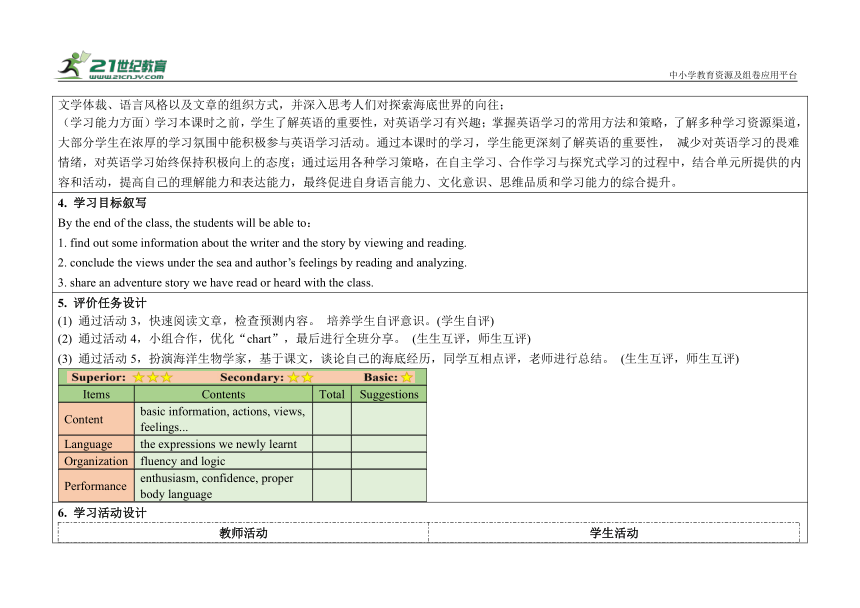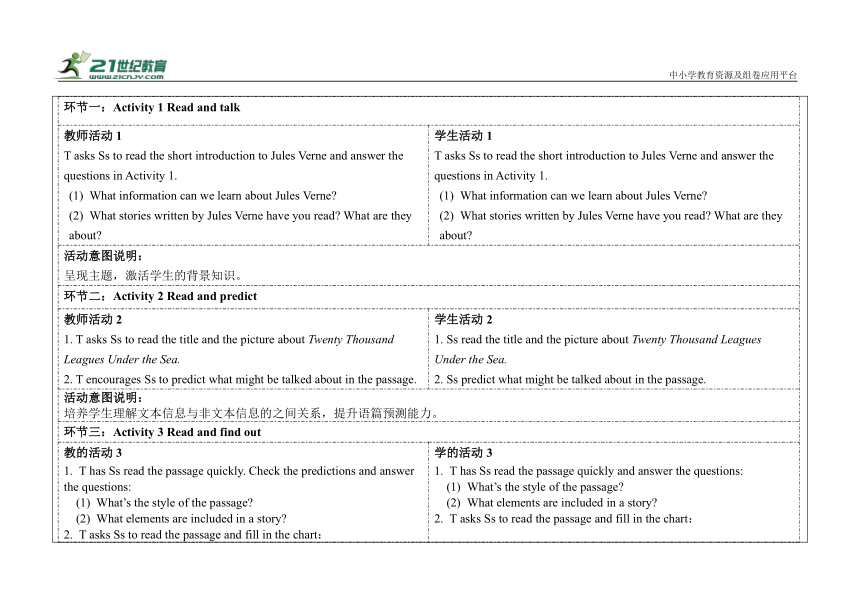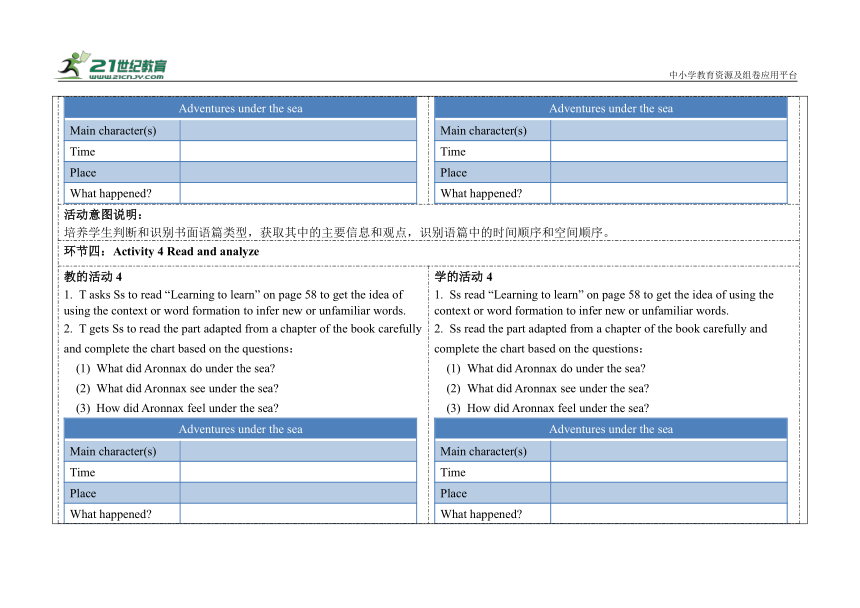(新课标)Unit 5 第8课时教学设计—外研版(新)必修第三册
文档属性
| 名称 | (新课标)Unit 5 第8课时教学设计—外研版(新)必修第三册 |  | |
| 格式 | docx | ||
| 文件大小 | 210.9KB | ||
| 资源类型 | 试卷 | ||
| 版本资源 | 外研版(2019) | ||
| 科目 | 英语 | ||
| 更新时间 | 2023-04-18 20:05:48 | ||
图片预览




文档简介
中小学教育资源及组卷应用平台
Book 3, Unit 5 What an adventure! 第8课时教学设计
内 容 Developing ideas (reading)+presenting ideas
课程标准分析 据课程标准在必修阶段的要求:学生能够在不太熟悉的语境中,围绕选择性必修课程内容所涉及的人与自我、人与社会和人与自然等主题语境,使用所学的语言知识和文化知识,综合运用学习策略,理解选择性必修课程所规定的不同类型语篇所传递的意义、意图和情感态度,理解语篇中不同的文化元素及其内涵,分析不同语篇类型的结构特征和语言特点,并能以口头或书面形式陈述事件、传递信息、再现真实或想象的经历、阐释观点和态度等。 与阅读技能相关的要求:能判断和识别书面语篇的意图,获取其中的主要信息和观点:使识别语篇中的主要事实与观点之间的逻辑关系,理解语篇反映的文化背景;能推断语篇中的隐含意义;能识别语篇中的内容要点和相应支撑论据;能根据定义线索,理解概念性词汇或术语;能理解文本信息与非文本信息的关系;能理解语篇成分之间的语义逻辑关系,如:次序关系、因果关系、概括与例证关系;能识别语篇中的时间顺序、空间顺序、过程顺序等;能在语境中理解具体词语的功能、词语的内涵和外延以及使用者的意图和态度;能理解语篇中特定语言的使用意图以及语言在反映情感态度和价值观中所起的作用;
教学内容分析 本课时为本单元第5课时,文章是文学名著选读,根据法国作家Jules Verne的科幻小说《海底两万里》的选段改写,属于记叙类文章。 文中通过Aronnax教授跟随Nemo船长在水下漫步的视角,呈现了海底的景色,着重描述了阳光透过水面的光线变化和海底的沙床行走的感受。通过赏析经典文学,帮助学生深化对主题意义的理解。
学生学情分析 (话题知识)学习本单元之前,学生在必修一、必修二的Unit5, Unit6已接触过人与自然的主题语境。通过本课时的学习,学生能够更深入理解该主题下的子话题。 (语言知识与技能)大部分同学能简单谈论动物、自然环境等;通过本课时的学习,学生通过赏析经典文学作品,可以初步了解科幻小说的文学体裁、语言风格以及文章的组织方式,并深入思考人们对探索海底世界的向往; (学习能力方面)学习本课时之前,学生了解英语的重要性,对英语学习有兴趣;掌握英语学习的常用方法和策略,了解多种学习资源渠道,大部分学生在浓厚的学习氛围中能积极参与英语学习活动。通过本课时的学习,学生能更深刻了解英语的重要性, 减少对英语学习的畏难情绪,对英语学习始终保持积极向上的态度;通过运用各种学习策略,在自主学习、合作学习与探究式学习的过程中,结合单元所提供的内容和活动,提高自己的理解能力和表达能力,最终促进自身语言能力、文化意识、思维品质和学习能力的综合提升。
学习目标叙写 By the end of the class, the students will be able to: 1. find out some information about the writer and the story by viewing and reading. 2. conclude the views under the sea and author’s feelings by reading and analyzing. 3. share an adventure story we have read or heard with the class.
评价任务设计 通过活动3,快速阅读文章,检查预测内容。 培养学生自评意识。(学生自评) 通过活动4,小组合作,优化“chart”,最后进行全班分享。 (生生互评,师生互评) 通过活动5,扮演海洋生物学家,基于课文,谈论自己的海底经历,同学互相点评,老师进行总结。 (生生互评,师生互评) ItemsContentsTotalSuggestionsContentbasic information, actions, views, feelings...Languagethe expressions we newly learntOrganizationfluency and logicPerformanceenthusiasm, confidence, proper body language
学习活动设计 教师活动学生活动环节一:Activity 1 Read and talk教师活动1 T asks Ss to read the short introduction to Jules Verne and answer the questions in Activity 1. What information can we learn about Jules Verne What stories written by Jules Verne have you read What are they about 学生活动1 T asks Ss to read the short introduction to Jules Verne and answer the questions in Activity 1. What information can we learn about Jules Verne What stories written by Jules Verne have you read What are they about 活动意图说明: 呈现主题,激活学生的背景知识。环节二:Activity 2 Read and predict教师活动2 1. T asks Ss to read the title and the picture about Twenty Thousand Leagues Under the Sea. 2. T encourages Ss to predict what might be talked about in the passage. 学生活动2 1. Ss read the title and the picture about Twenty Thousand Leagues Under the Sea. 2. Ss predict what might be talked about in the passage. 活动意图说明: 培养学生理解文本信息与非文本信息的之间关系,提升语篇预测能力。环节三:Activity 3 Read and find out教的活动3 T has Ss read the passage quickly. Check the predictions and answer the questions: What’s the style of the passage What elements are included in a story T asks Ss to read the passage and fill in the chart: Adventures under the seaMain character(s)TimePlaceWhat happened
学的活动3 T has Ss read the passage quickly and answer the questions: What’s the style of the passage What elements are included in a story T asks Ss to read the passage and fill in the chart: Adventures under the seaMain character(s)TimePlaceWhat happened
活动意图说明: 培养学生判断和识别书面语篇类型,获取其中的主要信息和观点,识别语篇中的时间顺序和空间顺序。环节四:Activity 4 Read and analyze教的活动4 T asks Ss to read “Learning to learn” on page 58 to get the idea of using the context or word formation to infer new or unfamiliar words. T gets Ss to read the part adapted from a chapter of the book carefully and complete the chart based on the questions: What did Aronnax do under the sea What did Aronnax see under the sea How did Aronnax feel under the sea Adventures under the seaMain character(s)TimePlaceWhat happened ActionsFeelingsViews
T encourages Ss to work in groups and check answers. T invites 2 or 3 groups to present their charts.学的活动4 Ss read “Learning to learn” on page 58 to get the idea of using the context or word formation to infer new or unfamiliar words. Ss read the part adapted from a chapter of the book carefully and complete the chart based on the questions: What did Aronnax do under the sea What did Aronnax see under the sea How did Aronnax feel under the sea Adventures under the seaMain character(s)TimePlaceWhat happened ActionsFeelingsViews
Ss work in groups and check answers. Ss present their charts to the whole class.活动意图说明: 培养学生根据上下文语境,猜测词语的功能、内涵等的能力;帮助学生分析语篇中的主要信息和相应支撑的细节信息,引导学生理解语篇中特定语言的使用意图以及语言在反映情感态度和价值观中所起的作用。环节五:Activity 5 Reconstruct and share教的活动5 1. T helps Ss understand the requirement of Activity 4. 2. T guides Ss to talk about their experiences by playing the marine biologist. 3. T encourages Ss to evaluate the performances. 学的活动5 1. Ss tyr to understand the requirement of Activity 4. 2. Ss talk about their experiences by playing the marine biologist. 3. Ss evaluate the performances. ItemsContentsTotalSuggestionsContentbasic information, actions, views, feelings...Languagethe expressions we newly learntOrganizationfluency and logicPerformanceenthusiasm, confidence, proper body language
活动意图说明: 巩固和整合语篇中所学的语言知识和文化知识,学会在相关情境下综合运用新知。环节六:Activity 6 Think and share教的活动6 T asks Ss to think of the following questions: Why did the author share this story with us What do you know about the world beneath the surface of the oceans Why do you think people want to explore the underwater world 学的活动6 Ss are encouraged to think of the following questions: Why did the author share this story with us What do you know about the world beneath the surface of the oceans Why do you think people want to explore the underwater world 活动意图说明: 鼓励学生深入理解语篇,了解作者的写作意图,逐渐超越语篇,联系自身,深度思考人与自然的关系,深入理解单元主题意义。
板书设计
作业与拓展学习设计 Homework: Step I:Think of an adventure story you have read or heard and make notes based on the chart below. Main character(s)TimePlaceWhat happened What do you think about the story
Step II:Write a composition about the adventure story based on your notes. (about 150 words) _________________________________________________________________________________________________________________________ _________________________________________________________________________________________________________________________ _________________________________________________________________________________________________________________________ _________________________________________________________________________________________________________________________ _________________________________________________________________________________________________________________________ ________________________________________________________________________________________________________________________ 第5课时课后作业
教学反思与改进 (留白)
Book 3, Unit 5 What an adventure! 第8课时教学设计
内 容 Developing ideas (reading)+presenting ideas
课程标准分析 据课程标准在必修阶段的要求:学生能够在不太熟悉的语境中,围绕选择性必修课程内容所涉及的人与自我、人与社会和人与自然等主题语境,使用所学的语言知识和文化知识,综合运用学习策略,理解选择性必修课程所规定的不同类型语篇所传递的意义、意图和情感态度,理解语篇中不同的文化元素及其内涵,分析不同语篇类型的结构特征和语言特点,并能以口头或书面形式陈述事件、传递信息、再现真实或想象的经历、阐释观点和态度等。 与阅读技能相关的要求:能判断和识别书面语篇的意图,获取其中的主要信息和观点:使识别语篇中的主要事实与观点之间的逻辑关系,理解语篇反映的文化背景;能推断语篇中的隐含意义;能识别语篇中的内容要点和相应支撑论据;能根据定义线索,理解概念性词汇或术语;能理解文本信息与非文本信息的关系;能理解语篇成分之间的语义逻辑关系,如:次序关系、因果关系、概括与例证关系;能识别语篇中的时间顺序、空间顺序、过程顺序等;能在语境中理解具体词语的功能、词语的内涵和外延以及使用者的意图和态度;能理解语篇中特定语言的使用意图以及语言在反映情感态度和价值观中所起的作用;
教学内容分析 本课时为本单元第5课时,文章是文学名著选读,根据法国作家Jules Verne的科幻小说《海底两万里》的选段改写,属于记叙类文章。 文中通过Aronnax教授跟随Nemo船长在水下漫步的视角,呈现了海底的景色,着重描述了阳光透过水面的光线变化和海底的沙床行走的感受。通过赏析经典文学,帮助学生深化对主题意义的理解。
学生学情分析 (话题知识)学习本单元之前,学生在必修一、必修二的Unit5, Unit6已接触过人与自然的主题语境。通过本课时的学习,学生能够更深入理解该主题下的子话题。 (语言知识与技能)大部分同学能简单谈论动物、自然环境等;通过本课时的学习,学生通过赏析经典文学作品,可以初步了解科幻小说的文学体裁、语言风格以及文章的组织方式,并深入思考人们对探索海底世界的向往; (学习能力方面)学习本课时之前,学生了解英语的重要性,对英语学习有兴趣;掌握英语学习的常用方法和策略,了解多种学习资源渠道,大部分学生在浓厚的学习氛围中能积极参与英语学习活动。通过本课时的学习,学生能更深刻了解英语的重要性, 减少对英语学习的畏难情绪,对英语学习始终保持积极向上的态度;通过运用各种学习策略,在自主学习、合作学习与探究式学习的过程中,结合单元所提供的内容和活动,提高自己的理解能力和表达能力,最终促进自身语言能力、文化意识、思维品质和学习能力的综合提升。
学习目标叙写 By the end of the class, the students will be able to: 1. find out some information about the writer and the story by viewing and reading. 2. conclude the views under the sea and author’s feelings by reading and analyzing. 3. share an adventure story we have read or heard with the class.
评价任务设计 通过活动3,快速阅读文章,检查预测内容。 培养学生自评意识。(学生自评) 通过活动4,小组合作,优化“chart”,最后进行全班分享。 (生生互评,师生互评) 通过活动5,扮演海洋生物学家,基于课文,谈论自己的海底经历,同学互相点评,老师进行总结。 (生生互评,师生互评) ItemsContentsTotalSuggestionsContentbasic information, actions, views, feelings...Languagethe expressions we newly learntOrganizationfluency and logicPerformanceenthusiasm, confidence, proper body language
学习活动设计 教师活动学生活动环节一:Activity 1 Read and talk教师活动1 T asks Ss to read the short introduction to Jules Verne and answer the questions in Activity 1. What information can we learn about Jules Verne What stories written by Jules Verne have you read What are they about 学生活动1 T asks Ss to read the short introduction to Jules Verne and answer the questions in Activity 1. What information can we learn about Jules Verne What stories written by Jules Verne have you read What are they about 活动意图说明: 呈现主题,激活学生的背景知识。环节二:Activity 2 Read and predict教师活动2 1. T asks Ss to read the title and the picture about Twenty Thousand Leagues Under the Sea. 2. T encourages Ss to predict what might be talked about in the passage. 学生活动2 1. Ss read the title and the picture about Twenty Thousand Leagues Under the Sea. 2. Ss predict what might be talked about in the passage. 活动意图说明: 培养学生理解文本信息与非文本信息的之间关系,提升语篇预测能力。环节三:Activity 3 Read and find out教的活动3 T has Ss read the passage quickly. Check the predictions and answer the questions: What’s the style of the passage What elements are included in a story T asks Ss to read the passage and fill in the chart: Adventures under the seaMain character(s)TimePlaceWhat happened
学的活动3 T has Ss read the passage quickly and answer the questions: What’s the style of the passage What elements are included in a story T asks Ss to read the passage and fill in the chart: Adventures under the seaMain character(s)TimePlaceWhat happened
活动意图说明: 培养学生判断和识别书面语篇类型,获取其中的主要信息和观点,识别语篇中的时间顺序和空间顺序。环节四:Activity 4 Read and analyze教的活动4 T asks Ss to read “Learning to learn” on page 58 to get the idea of using the context or word formation to infer new or unfamiliar words. T gets Ss to read the part adapted from a chapter of the book carefully and complete the chart based on the questions: What did Aronnax do under the sea What did Aronnax see under the sea How did Aronnax feel under the sea Adventures under the seaMain character(s)TimePlaceWhat happened ActionsFeelingsViews
T encourages Ss to work in groups and check answers. T invites 2 or 3 groups to present their charts.学的活动4 Ss read “Learning to learn” on page 58 to get the idea of using the context or word formation to infer new or unfamiliar words. Ss read the part adapted from a chapter of the book carefully and complete the chart based on the questions: What did Aronnax do under the sea What did Aronnax see under the sea How did Aronnax feel under the sea Adventures under the seaMain character(s)TimePlaceWhat happened ActionsFeelingsViews
Ss work in groups and check answers. Ss present their charts to the whole class.活动意图说明: 培养学生根据上下文语境,猜测词语的功能、内涵等的能力;帮助学生分析语篇中的主要信息和相应支撑的细节信息,引导学生理解语篇中特定语言的使用意图以及语言在反映情感态度和价值观中所起的作用。环节五:Activity 5 Reconstruct and share教的活动5 1. T helps Ss understand the requirement of Activity 4. 2. T guides Ss to talk about their experiences by playing the marine biologist. 3. T encourages Ss to evaluate the performances. 学的活动5 1. Ss tyr to understand the requirement of Activity 4. 2. Ss talk about their experiences by playing the marine biologist. 3. Ss evaluate the performances. ItemsContentsTotalSuggestionsContentbasic information, actions, views, feelings...Languagethe expressions we newly learntOrganizationfluency and logicPerformanceenthusiasm, confidence, proper body language
活动意图说明: 巩固和整合语篇中所学的语言知识和文化知识,学会在相关情境下综合运用新知。环节六:Activity 6 Think and share教的活动6 T asks Ss to think of the following questions: Why did the author share this story with us What do you know about the world beneath the surface of the oceans Why do you think people want to explore the underwater world 学的活动6 Ss are encouraged to think of the following questions: Why did the author share this story with us What do you know about the world beneath the surface of the oceans Why do you think people want to explore the underwater world 活动意图说明: 鼓励学生深入理解语篇,了解作者的写作意图,逐渐超越语篇,联系自身,深度思考人与自然的关系,深入理解单元主题意义。
板书设计
作业与拓展学习设计 Homework: Step I:Think of an adventure story you have read or heard and make notes based on the chart below. Main character(s)TimePlaceWhat happened What do you think about the story
Step II:Write a composition about the adventure story based on your notes. (about 150 words) _________________________________________________________________________________________________________________________ _________________________________________________________________________________________________________________________ _________________________________________________________________________________________________________________________ _________________________________________________________________________________________________________________________ _________________________________________________________________________________________________________________________ ________________________________________________________________________________________________________________________ 第5课时课后作业
教学反思与改进 (留白)
